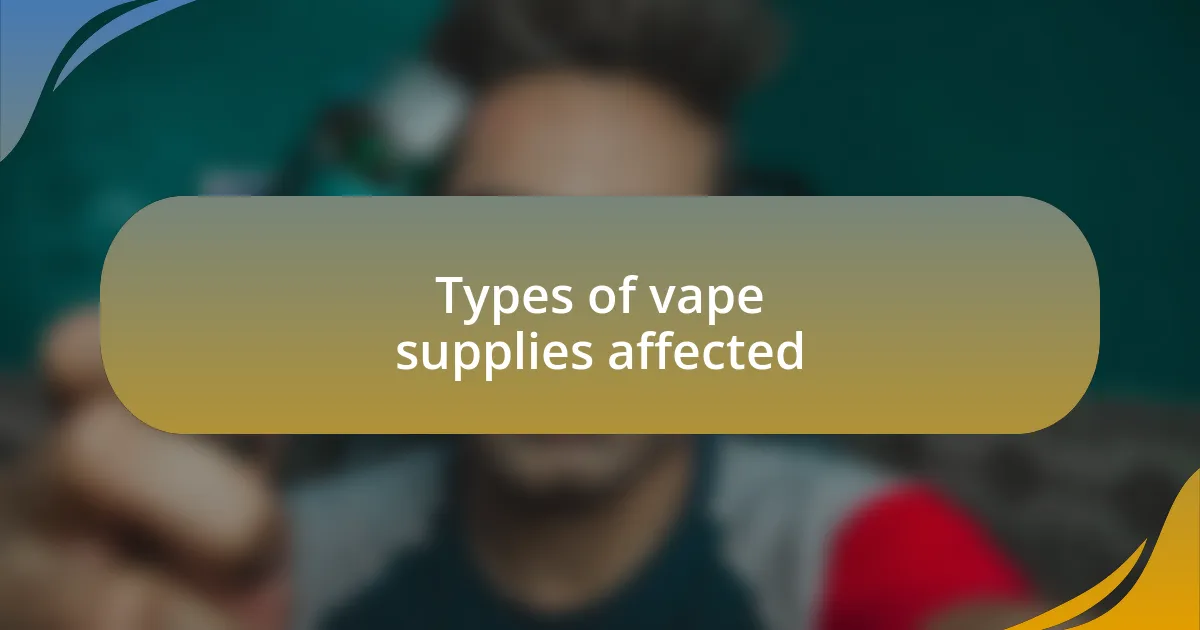Key takeaways:
- Vape regulations differ significantly by region, with age restrictions and labeling rules playing a major role in consumer safety and public health.
- Compliance is essential for businesses to avoid fines and reputational damage, while also ensuring the safety of products for consumers.
- Vape supplies like e-liquids, devices, and accessories are all subject to regulations that ensure their safety and quality.
- Staying informed about local regulations helps consumers navigate the changing landscape and advocate for their rights within the vaping community.

Understanding vape regulations
To truly grasp the landscape of vape regulations, it’s crucial to understand that they vary dramatically from one region to another. When I first ventured into the vaping community, I was surprised by how much local laws could differ—even within the same state. I often found myself asking, how can something so simple be regulated in such complex ways?
As I’ve navigated through these regulations, I’ve discovered that age restrictions are among the most common legal parameters. I remember a time when a friend was unable to purchase vape products because they didn’t meet the minimum age requirement. It was an eye-opener for me; I realized that these rules aren’t just red tape—they’re in place to protect public health, particularly for younger individuals who might be more susceptible to nicotine addiction.
Furthermore, understanding labeling and marketing rules is another layer of complexity. I know firsthand how misleading product claims can be—it was frustrating to encounter brands that glamorize their products while glossing over essential health warnings. This experience made me wonder: how can we ensure that consumers are adequately informed? The answer lies in not only staying updated with regulations but also advocating for transparency in the industry.

Importance of compliance in vaping
Compliance in vaping is vital, not just for businesses but also for consumers. I remember attending an industry expo where a panelist stressed that following regulations could mean the difference between thriving and going under. That really hit home for me. Without compliance, a brand risks hefty fines, loss of reputation, and even the potential to be shut down.
What often surprises people is how regulations safeguard consumer safety. I’ve met many vapers who struggled to grasp why some products were pulled from shelves. I used to think it was all about profit margins, but I learned that compliance ensures that e-liquids contain safe ingredients and are manufactured in sanitary conditions. It’s about protecting us as consumers, which is something we should all value.
Ultimately, the importance of compliance goes beyond mere legality—it’s about fostering trust in the vaping community. A few years back, I encountered a local shop that refused to sell unregulated products. I felt a sense of reassurance knowing they had our health in mind, which encouraged me to become a loyal customer. If everyone approached vaping with the same commitment to compliance, we’d build a safer, more reliable environment that benefits everyone involved.

Types of vape supplies affected
When we discuss types of vape supplies affected by regulations, it’s crucial to highlight e-liquids first. I remember when a popular flavor was suddenly banned, and vapers were left in a frenzy. It made me realize how closely tied our enjoyment is to what’s regulated—each flavor we love must pass safety tests to ensure there are no harmful ingredients. So, the next time you reach for your favorite mint or fruit blend, think about the oversight that guarantees it’s safe.
Devices themselves are another significant area impacted by regulations. I can distinctly recall a friend buying a high-tech vape mod only to find out later that it didn’t comply with the latest safety standards. It was a wake-up call for both of us: not all mods are created equal, and those that skirt regulations can pose real risks. This experience really drove home the importance of choosing compliant devices, not just for the sake of legality, but for our own well-being.
Lastly, accessories such as pods and coils are often overlooked, yet they too face regulation. I had a vivid moment when a retailer informed me that certain coils had been flagged due to potential manufacturing defects. Hearing that made me appreciate the layers of scrutiny involved. I urge everyone to consider how these accessories are not just afterthoughts; they’re critical components in ensuring the entire vaping experience is safe and enjoyable. How often do you think about the small parts that make your device work? It’s eye-opening, isn’t it?

Personal experiences with vape laws
Navigating the changing landscape of vape regulations has been quite an experience for me. I recall when my local shops suddenly stopped carrying certain flavors I had grown fond of. It felt frustrating and isolating, as if a piece of my vaping journey was snatched away overnight, prompting me to explore online options and cross my fingers that the flavors were still available somewhere.
One of the more perplexing moments came when I received a notice about upcoming restrictions on devices. I had just splurged on a new vape pen, and the thought that it might soon be considered non-compliant sent a wave of anxiety through me. This incident made me think about my purchases more critically; it pushed me to stay informed about each model’s legality, which sometimes felt like trying to navigate a maze without a map.
Interestingly, I’ve also witnessed how these regulations have influenced the community. I participated in a discussion group where several vapers shared their insights on product safety. It was enlightening to hear firsthand how these laws affect not just what we can buy, but how we see the act of vaping itself. Have you ever paused to think about the broader implications of these laws on the vaping culture? It definitely stirred up a mix of emotions among us—anger, confusion, and a shared determination to advocate for our choices.

Navigating local regulations effectively
Understanding local regulations around vaping can really shape your experience. I vividly remember attending a local town hall meeting where lawmakers discussed proposed vaping bans. Listening to the fears and assumptions shared by some attendees made me realize how disconnected the decision-makers were from our community’s actual experiences. I found myself wondering: Why is it so hard for lawmakers to see the positive aspects of vaping as a smoking alternative?
As I dove deeper into the regulations, I discovered various resources that could help me stay informed, such as local advocacy groups and online forums. One day, a fellow vaper shared a link to an updated legal guide specific to our state, which was a game-changer for me. It was almost like finding a treasure map; with this knowledge, I felt more empowered to engage in discussions about vaping laws and share accurate information with others.
On another note, I encountered a point where one of my favorite shops had to change the products they offered due to new restrictions. I remember walking in and seeing the empty shelves, feeling a sense of loss for what was there before. It struck me: what if this is happening everywhere? This made me realize the importance of supporting businesses that advocate for our rights and educating ourselves on how regulations can shift, influencing not just what we vape but also where we buy it from.